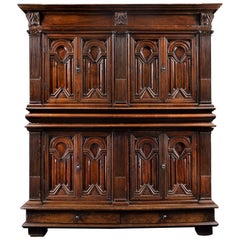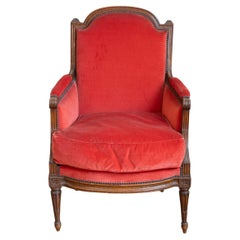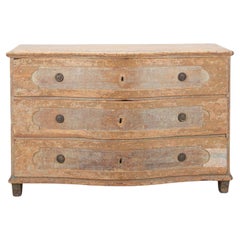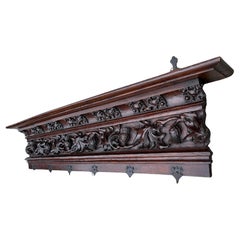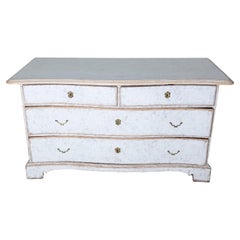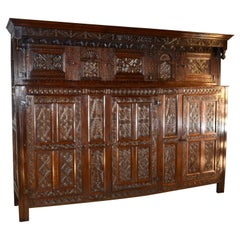Wood Furniture
to
1,933
8,980
7,876
17,325
2,324
1,922
1,037
1,021
946
577
137
126
73
63
46
31
11
8
7
5
3
17,325
53,491
152,382
70,132
23,174
82,038
28,578
3,800
1,180
4,119
6,594
6,633
18,716
23,777
14,715
4,829
1,889
17,325
8,316
6,921
4,913
4,002
14,716
4,037
3,796
3,339
3,037
17,325
17,325
17,325
234
37
11
9
6
Period: 18th Century and Earlier
Material: Wood
Renaissance Palace Wardrobe with Perspectival Views
Located in Saint-Ouen, FR
A rare carved walnut wardrobe opening with four door-leaves and two drawers in the lower part. The doors bear architectural views in low reliefs, fluted pilasters and Ionic capitals.
Upper Body
Two door-leaves with carved architectural perspectives open the wardrobe framed by three fluted pilasters with Ionic capitals.
Each door-leaf depict two semi-circular arcades whose cornice and base shows a central vanishing point. Likewise the pavement’s lines act for the artisan as a way to create depth. The vaulting instead leads us to think the vanishing point has to be situated where the handle is, between the two complementaries reliefs.
The elegant moulded belt hides an internal secret space, accessible through a moveable plank in the upper body.
Lower Body
Two door-leaves identical to those of the upper body framed by three fluted pilasters with Doric capitals. The base of the wardrobe opens with two large drawers.
The sides also bear panels depicting architectural perspectives. The external pilasters share their Ionic capital with the facade’s pilasters. Thus we can observe on the wardrobe’s sides the capital’s lateral parts with the elegant volute specific to the Ionic order.
This palace wardrobe is topped by an overlapping cornice standing on three consoles for the facade and two consoles on each sides. Placed right above the pilasters each console are adorned by fully expanded leaves.
During the 15th century a major interest for architecture and perspective studies arises and influences patrons tastes. The work of great theorists such as Leon Battista Alberti...
Category
16th Century Italian Renaissance Antique Wood Furniture
Materials
Walnut
French 18th Century Louis XVI Bergere
Located in Atlanta, GA
This exquisite 18th-century French Louis XVI bergère embodies the refined elegance and craftsmanship of the period. Featuring a carved wooden frame, likely crafted from walnut, the c...
Category
18th Century French Louis XVI Antique Wood Furniture
Materials
Walnut
18th Century Italian Commode
Located in Gloucestershire, GB
A beautiful 18th Century Italian Commode of great proportions with remains of its original paint.
Lovely muted colours - a delightful piece!
Circa 1770.
Category
18th Century Italian Antique Wood Furniture
Materials
Wood, Paint
Early Antique Gothic Revival Coat Rack with Hand Forged Wrought Iron Hooks 18thC
Located in Lisse, NL
Wonderful craftsmanship, deeply carved, solid oak, Gothic Revival wall coat rack.
Anyone who has ever visited a Gothic (Revival) church or another Gothic style building will immedia...
Category
18th Century French Gothic Revival Antique Wood Furniture
Materials
Wrought Iron
18th Century Swedish Chest of Drawers Circa 1790
Located in Atlanta, GA
This exquisite 18th-century Swedish chest of drawers, circa 1790, exemplifies the timeless elegance of Gustavian design. Constructed from pine wood, it features a soft white painted ...
Category
18th Century Swedish Gustavian Antique Wood Furniture
Materials
Pine
Dated 1688 English Joined Press Cupboard
Located in High Point, NC
Dated 1688 James II period oak joined press cupboard from Northern England, probably Westmoreland and the Lake District area. The top has a lovely crown molding, over five hand carv...
Category
17th Century English James II Antique Wood Furniture
Materials
Oak
18th Century Italian Cross with Kyanite, Calcite Crystals, and Baroque Pearls
By Interi
Located in Dublin, Dalkey
18th century Italian crucifix with gold-plated kyanite, calcite crystals in matrix, and baroque pearls. The crucifix is originally from a church in Liguria. It is hand-carved and pai...
Category
18th Century Italian Rococo Antique Wood Furniture
Materials
Rock Crystal, Gold Plate, Gold Leaf
George III mahogany Chest on Chest
Located in Flower Mound, TX
George III mahogany chest on chest, the projecting molded and dentil cornice over plain frieze, fitted with two short and six graduating drawers with oak linings, on bracket feet
Category
Late 18th Century English Georgian Antique Wood Furniture
Materials
Mahogany
French Antique Oak & Wrought Iron Buffet Country Style 18th Century
Located in Labrit, Landes
French antique oak and wrought iron sideboard buffet.
Two doors and two drawers.
One shelf in the cabinet.
The interior of the buffet was entirely covered in Provencal-style fabric w...
Category
18th Century French French Provincial Antique Wood Furniture
Materials
Wrought Iron
Orologio a Pendolo in Legno Laccato Style barocco veneziano 700
Located in Cantù, IT
Meraviglioso Orologio a Pendolo in Legno Laccato Style barocco veneziano 700 provenienza villa reale lago maggiore produzione mice versailles anni 6...
Category
1790s Baroque Antique Wood Furniture
Materials
Wood
18th Century Italian Dining Table
Located in Gloucestershire, GB
18th Century Italian table with a nicely patinated and worn pine top.
The base is in its original blue. Sturdy tapered legs and an 18cm deep apron with squared beading trim.
Category
18th Century Italian Antique Wood Furniture
Materials
Pine, Paint
Polychrome carved wood Virgin and Child from the 15th Century
Located in Saint-Ouen, FR
POLYCHROME CARVED WOOD VIRGIN AND CHILD FROM THE 15TH CENTURY
ORIGIN: SOUTH GERMANY, SWABIA, NUREMBERG REGION
PERIOD: 15th CENTURY
Height: 94,6cm
Width : 28 cm
Depth : 18 cm
Lime wood
Original Polychromy
Good state of conservation
From 1430 onwards, sculpture underwent a profound stylistic renewal which continued until 1530, the so-called late Gothic period. In the Germanic countries, original sculptures flourished in an expressive and sensitive vein.
This renewal was inspired by the art of Nicholas of Leiden, who was active in Strasbourg in the 1460's. His style broke with the refined and delicate art of the international Gothic style in force throughout Europe around 1400. The figures became more authentic and realistic. The bodies became denser. Clothes are animated by deep, broken folds, the fabrics are heavy and have a great decorative value. In addition, the polychromy is intended to be illusionistic. The painting makes it possible to restore the texture of the materials, the richness of the textiles and the natural skin tone of the characters.
The dissemination of images through engraving and the great mobility of the artists led to the success of this style, which conquered the Upper Rhine, Swabian, Tyrolean and Franconian regions, contributing to the formation of a common stylistic identity in these regions. The economic boom in the flourishing German cities was conducive to the development of original production. Attracted by this prosperity, numerous workshops were set up in order to meet the orders of religious communities, the Church and the laity, including a clientele of middle-class rockers.
This precious Virgin and Child is depicted standing on a crescent moon, her head encircled by a crown of tall flowers. Her long wavy hair spreads over her shoulders, framing her beautiful oval face. Under fine eyebrows drawn with a brushstroke, her almond-shaped, slightly drooping eyes look at the Child with infinite softness. She is dressed in a long red dress with a rounded neckline, belted under the chest. The heavy fabric of her dress spreads out in broken folds at her feet. On her shoulders she wears a golden cloak. The drapery has deep folds. She holds out her right hand while she holds the Christ Child with her left.
Christ, with his well-defined hair, is naked. His cheeks are highlighted with red, he holds an apple in his left hand and with the other hand makes a sign of blessing towards the faithful.
Virgins with Child on a crescent moon were very popular in the second half of the 15th century, especially as the central subject of altarpieces in southern Germany and Austria. The crescent moon on which Mary is standing is reminiscent of the Woman of the Apocalypse. Often equated with the Virgin Mary.
This episode is taken from the Book of Revelation (12:1-6)
1 Then a great sign appeared in heaven: a woman clothed with the sun, with the moon under her feet and a crown of twelve stars on her head. ; 2 She was pregnant, and she cried out because she was in labor, in pain from giving birth. ; 3 Then another sign appeared in heaven: it was a great fiery red dragon, with seven heads and ten horns, and seven royal crowns on his heads. ; 4 His tail swept down a third of heaven's stars and threw them to the earth. The dragon stood in front of the woman who was about to give birth so that when she gave birth, he might devour her child. ; 5 She gave birth to a son, a male child who is to rule all the nations with an iron rod. Her child was snatched up to God and his throne. ; 6 Then the woman fled into the desert, where God has prepared a place for her. There she will be taken care of for one thousand two hundred sixty days.
Some theologians see in this woman a reference to the Virgin Mary and in the child, Jesus.
This remarkable work is a very fine example of sculpture from Swabian workshops in the last decades of the 15th century. It presents all the characteristic stylistic elements: a highly girdled silhouette, an abundant drapery with angular folds, but also a great physical presence accentuated by the polychromy that restores the anatomical details. This group is made of a wooden log. The deep folds of the drapery highlight the movement of the Virgin holding the child.
Bibliography :
Sophie Guillot de Suduiraut, Dévotion et Séduction, Sculptures souabes des musées de France, vers 1460-1530, Paris musée du Louvre-Éditions somogy, 2015
“Revelation 12 - Common English Bible...
Category
15th Century and Earlier German Gothic Antique Wood Furniture
Materials
Wood
18th Century French Walnut Commode, Castres, Pyrénées, circa 1760
Located in Brooklyn, NY
18th century French Walnut Commode, Castres, Pyrénées, c. 1760
Dry walnut, Original Pulls, later Escutcheons
H: 32 D: 24 W: 50 in.
Category
18th Century French Baroque Antique Wood Furniture
Materials
Walnut
Antique 18th Century Spanish Baroque Chestnut Desk or Sidetable
Located in Casteren, NL
This beautiful rustic desk or sidetable was made in Northern Spain around 1760. The top is made from one ! solid plank of chestnut that is 1,18 inch thick. It is joined to the base w...
Category
Late 18th Century Spanish Baroque Antique Wood Furniture
Materials
Chestnut
Ptolemaic Armillary Sphere, Charles-François Delamarche, Paris, ante 1798
Located in Milano, IT
Ptolemaic armillary sphere
Charles-François Delamarche
Paris, ante 1798
Wood and papier-mâché
covered with printed and partly hand-colored paper
It measures 15.55 in in height x Ø 10...
Category
1790s French Other Antique Wood Furniture
Materials
Wood, Paper
Antique Scottish Oak Coffer, Large 18th Century Panelled Blanket Box + Drawers
Located in Leicester, GB
Large Scottish 18th Century Solid Oak Blanket Chest. The antique blanket chest has a large top-opening box on top of a chest of drawers. The drawers are deep and fairly slim. Lovely ...
Category
18th Century Scottish Georgian Antique Wood Furniture
Materials
Oak
Matched Pair of George III Gainsborough Chairs
Located in Greenwich, CT
Fine matched pair of George III mahogany Gainsborough chairs with shaped backs, the arms with blind fretwork carving, the square legs similarly carved and joined by pierced fretwork ...
Category
1770s English Chinese Chippendale Antique Wood Furniture
Materials
Suede, Mahogany
Pair of Swedish Gustavian marble top pier tables, c. 1790
Located in Kenilworth, IL
Pair of unusually small pair of carved & painted Gustavian hardwood console tables with original gray and white Saint Anne marble tops. The marble tops rest on a guilloché carved apr...
Category
Late 18th Century Swedish Gustavian Antique Wood Furniture
Materials
Marble
18th Century Icon on Board of the Resurrection of Christ
Located in Hastings, GB
Glorious Icon on Oak board dating to the 18th century and depicting the Resurrection of Christ, this Icon was originally from Mount Athos a mountain on th...
Category
1790s Greek Renaissance Antique Wood Furniture
Materials
Wood
Italian Neoclassical Commode With Walnut Veneer, 18th Century
Located in Viterbo, VT
Neoclassical chest of drawers hand-made in Italy in the late 1700s using walnut and decorated with walnut veneer. The chest is very straight in lines, however, the cross-banded venee...
Category
Late 18th Century Italian Neoclassical Antique Wood Furniture
Materials
Walnut
Important Beau Brummell Regency Period Flame Mahogany Gentleman's Dressing Table
Located in Forney, TX
A rare and spectacular George III period (1760-1820) Beau Brummell gentleman's dressing table.
There is no mistaking this remarkably distinctive table's complex design and superb quality, which is certain to attract attention, add interest, and become a conversational talking point wherever you place it. Metamorphic like, the multipurpose piece transforming from a library table or console - vanity - work table - writing desk)
Refined elegant sophistication at its finest, born in late 18th / early 19th century at the height of the George III Regency period, also known as the golden age of classical English furniture design.
Exquisitely hand-crafted of the finest mahogany, having a rectangular top with warm, rich, highly figured swirl - flame mahogany, contrasting satinwood string banding and intricate cross-banded inlays, covered with an optional later glass top, above a trio of drawers affixed with beautiful gilt brass lion pull hardware, the center drawer opening to reveal a divided interior fitted with numerous compartments, richly grained mahogany veneered lids, and a lovely Worcester porcelain desk set.
Above the drawer a pull-out panel with inset green felt functions as both a writing - work surface extension and brushing slide.
Flanking the main drawer, a pair of drawers slide-outward and open to reveal brass hinged large panel mirrors that can also be used to double the work surface, when lifted the mirrors can rotate and additional lidded storage compartments are revealed, including a pin cushion for sewing, horse hair bristle brush, and divided slots coin compartment.
Having elegant clean lines, simple apron, highest-quality reinforced drawers to support the additional weight and allow them to fully extend, all rising on tapered square legs, terminating in patinated brass capped feet with casters.
Dimensions: (approx)
29.5" High, 44.5" Wide, 25.75" Deep (table form)
Provenance:
From the Collection of Gloria Monnet Nicholson, Tulsa, Oklahoma
Acquisition:
Acquired from highly reputable auction house Heritage Auctions, Dallas, Texas. June 2022 Fine Furniture & Decorative Arts Signature Auction #8085 catalog.
Who was Beau Brummell:
George Bryan "Beau" Brummell (1778–1840) was an important figure in Regency England and, for many years, the arbiter...
Category
Late 18th Century English Georgian Antique Wood Furniture
Materials
Brass
Italian Baroque Gilded Cartouche Sculpted Frame Early 1600s
Located in Milano, MI
Hand carved Baroque Cartouche frame of rectangular shape formed by deep volutes that connect with two central keys and foliage with the bulbous ribbing near the corners. Gilded in ...
Category
Early 17th Century European Baroque Antique Wood Furniture
Materials
Gold Leaf, Silver Leaf
A Pair of 18th Century Italian painted and Gilt Wooden Candlesticks
Located in Bishop's Stortford, GB
A Pair of 18th Century Italian painted and Gilt Wooden Candlesticks, Candle Holders CIRCA 1750'S, Set upon Lion Paw Tri Feet with ornate carvings and decorated stems these beautfully...
Category
Mid-18th Century Italian George III Antique Wood Furniture
Materials
Giltwood
17th Century Spanish Writing Table - Desk
Located in Atlanta, GA
An outstanding and very handsome 17th century Spanish Writing Table - Desk from the Catalan region of Spain. Beautifully constructed from stunning walnut & chestnut with drawers, a ...
Category
17th Century European Antique Wood Furniture
Materials
Chestnut, Walnut
Early 18th Century Antique Welsh Hunt Board for Restoration
Located in Bridgeport, CT
A early Rustic antique and diminutive Hunt Board is crafted from oak and walnut construction.
Supported on four cabriole legs with a strongly carved, scalloped apron below the comp...
Category
18th Century Welsh Antique Wood Furniture
Materials
Brass
18th Century, Heavily Carved Bone Inset & Iron Mounted Spanish Vargueno
Located in Atlanta, GA
Spanish, 18th century or earlier.
An 18th century Spanish bargueno or vargueno traveling desk, used for storing documents, jewels, or sewing box. The six drawer chest is inset with ...
Category
18th Century Spanish Baroque Antique Wood Furniture
Materials
Iron
18th Century French Transition Period Walnut Armchair with Scrolling Arms
Located in Atlanta, GA
A French walnut Transition period armchair from the 18th century with scrolling arms, fluted tapering legs and carved stretchers. A French walnut Transition period armchair from the ...
Category
18th Century French Antique Wood Furniture
Materials
Upholstery, Walnut
18th Century Bureau Plat Mahogany France 1780 Writing Desk with Side Drawers
Located in Epfach, DE
A bureau plat from the late 18th century, made around 1780 in the French style, epitomises the timeless elegance and craftsmanship of furniture design from this era. Made from fine m...
Category
1780s French Louis XVI Antique Wood Furniture
Materials
Mahogany
French 18th Century Console Table
Located in Stockbridge, GA
This wonderful 18th Century Console Table is made of walnut with a beautiful patina and the use of age. It has 2 drawers with 2 iron rings as hardware.
Category
Late 18th Century French Louis XIII Antique Wood Furniture
Materials
Walnut
18th Century Monumental French Pine Drapers Table Store Display
Located in Rio Vista, CA
Rare authentic 18th century monumental French drapers trestle table or store display featuring 16 work drawers. This massive work table was used in a mercery or Habadashery by cloth merchants or drapers to cut and sew long bolts of fabric. The drapers could work on each side of the table and use the drawers to store cutting tools...
Category
18th Century French Industrial Antique Wood Furniture
Materials
Iron
A French Louis XVI painted and carved daybed, 18th C
Located in Philadelphia, PA
French Louis XVI painted and carved daybed, 18th C. Beautifully carved with with spiral fluted columns supporting upholstered head and footboards, top...
Category
18th Century French Louis XVI Antique Wood Furniture
Materials
Wood
French Semainier or Tall Chest of Mahogany with Marble Top
Located in Austin, TX
A handsome French semainier or tall chest of mahogany from the late 18th century, featuring a white marble top over a frieze with seven drawers betwee...
Category
Late 18th Century French Antique Wood Furniture
Materials
Stone, Marble, Metal, Brass
IMPORTANT PORTUGUESE ORATORY WITH CALVARY 18th Century
Located in Madrid, ES
IMPORTANT PORTUGUESE ORATORY WITH CALVARY 18th Century
Portuguese, from the 18th century
in carved Brazilian rosewood.
Decoration with interrupted pediments, volutes, floral motifs...
Category
Early 18th Century Portuguese Baroque Antique Wood Furniture
Materials
Silver
Immaculate Conception Religious Sculpture, Baroque, 18th Century
Located in Lisbon, PT
An exceptional 18th-century Spanish Baroque sculpture of the Immaculate Conception, carved in chestnut wood and richly polychromed and crowned.
The sculpture retains its vibrant pi...
Category
18th Century Spanish Baroque Antique Wood Furniture
Materials
Metal, Brass, Gold Leaf
18th Century French Louis XVI Period Commode in Stripped Oak
Located in Dallas, TX
18th Century French Louis XVI Period Commode in Stripped Oak was lovingly hand-crafted during the waning years of the Louis XVI period, created out of dense, old-growth indigenous oa...
Category
1780s French Louis XVI Antique Wood Furniture
Materials
Brass
Set of Four Italian Walnut Savonarola Armchairs
Located in Saint-Ouen, FR
Set of four Italian walnut Savonarola armchairs
ORIGIN : FLORENCE, ITALY
PERIOD : LATE 15TH CENTURY - EARLY 16TH CENTURY
Measures: height : 102 cm 40.15 inches, height : 93 cm 36.61 inches
length : 68 cm 26.77 inches, length : 68 cm 26.77 inches
depth : 55 cm 21.65 inches, depth : 50 cm 19.68 inches
Walnut
Very good condition
This movable Italian seat from the late 15th century descents from the roman curule seat. It took the name of sedia Savonarola...
Category
16th Century Italian Renaissance Antique Wood Furniture
Materials
Walnut
Decorated Venetian Neoclassical Commode
Located in Greenwich, CT
Very fine 18th century Italian, probably Venetian three-drawer commode, the top faux painted to simulate Sienna marble, over three graduated drawers festooned with floral and ribbon ...
Category
Late 18th Century Italian Neoclassical Antique Wood Furniture
Materials
Poplar
18th Century Spanish Polychromed Tabernacle, Niche
Located in Atlanta, GA
18th century spanish polychromed tabernacle, niche for the display of Santos. Original finish in somber tones of ochre and siena.
Category
18th Century Spanish Antique Wood Furniture
Materials
Wood
Superb French 1780s era Walnut Upholstered Louis XV Settee Canape
Located in Swedesboro, NJ
This is a gorgeous hand-carved 1780ss French settee. The settee shows its original finish with its original signs of age and use and minor antique repairs. The upholstery is still qu...
Category
1780s French Louis XV Antique Wood Furniture
Materials
Walnut
18th/19th Century Spanish Colonial Carved Polychrome Wood Santo Altar Sculpture
Located in Forney, TX
A most impressive antique Spanish Colonial hand carved polychromed wood Santo Catholic church altar figure. circa 1800
Hand-crafted in the late 18th / early 19th century, exceptionally executed intricate detailing, the large scale antique religious sculpture depicting the female Saint Teresa of Avila, polychrome painted gesso over finely sculpted wood, inset glass eyes, shown in Carmelite nun habit...
Category
Late 18th Century Spanish Colonial Antique Wood Furniture
Materials
Gesso, Wood, Paint
18th Century English Oak Sideboard
Located in High Point, NC
18th century oak sideboard from England with a plank top, following down to hand paneled sides and a single candle drawer in the front, flanked by cushion paneled drawers. There are applied turnings flanking the drawers as well, for added interest. All of the drawers have hand carved beaded...
Category
18th Century English William and Mary Antique Wood Furniture
Materials
Oak
18th Century Original Painted Large Pine Chest of Four Drawers, Denmark
Located in Round Top, TX
This large chest of four drawers is a wonderful find. The hand-painted finish is all original, dating to the mid to late 1700's.
The lovely floral painted details and flourishes wer...
Category
Mid-18th Century Danish Folk Art Antique Wood Furniture
Materials
Wood, Paint
Period Georgian Tea Caddy, Circa 1790-1810
Located in High Point, NC
Circa 1790-1810 period Georgian tea caddy made from Mahogany. The tea caddy has been used well and loved over many centuries. The top has a brass ring with which to lift the lid. ...
Category
Late 18th Century English Georgian Antique Wood Furniture
Materials
Mahogany, Satinwood
Pair of 18th Century French Communication Doors
Located in Atlanta, GA
This pair of 18th-century French communication doors displays an elegant blend of craftsmanship and rustic charm. Constructed from solid wood, likely walnut, they feature beautifully...
Category
18th Century French Louis XIV Antique Wood Furniture
Materials
Walnut
Beautiful Turned Birch Wood Bowl from Bohuslän, Sweden ca 1750
Located in Farsta, SE
Beautiful Turned Birch Wood Bowl
from Bohuslän, Sweden ca 1750
Great patina and a timeless shape.
Height: 9.5 cm/3.7 inch
Diameter: 23 cm/9 inch
Category
Mid-18th Century Swedish Scandinavian Modern Antique Wood Furniture
Materials
Birch
18thc English Oak Welsh Cupboard with Five Drawers and Bone Escutcheons
Located in Savannah, GA
This rare stately 18th century oak cupboard is from the Wales region of Great Britain and is composed of three shelves with rails for placing plates across the top. The bottom of the...
Category
1780s Welsh Georgian Antique Wood Furniture
Materials
Brass
Renaissance Cabinet from Burgundy or Lyon Region
Located in Saint-Ouen, FR
Renaissance cabinet from Burgundy Or Lyon Region
Origin : Burgundy Or Lyon, France
Period : Second Half 16th Century, C. 1580
Height : 209cm
Length : 184cm
Depth : 71cm
Good condition
Walnut wood, original keys and keyholes
Around the middle of the 16th century the conception and ornamentation of French furniture evolves. The start of major building projects, such as the castle of Fontainebleau, gives artists a new impulse. Inventive and rich formulas are developed there, before spreading to all of Europe thanks to engravings and printed leaflets. Furthermore, Italian artists working on such construction sites bring French artists and patrons a renewed taste for the Antique.
Regarding the art of furnitures, the most complex scenes and figures are drawn from illustrated books, ornament and emblem compendiums and engraving compilations. Rather than copying those images the artisans feed their inspiration and decline the motifs in numerous variations.
The ornamental grammar marks a return to the Antique : palm leaf, acanthus, egg-and-dart, greek, scroll, fluted pilaster… It is in Primaticcio’s and Il Rosso’s stuccos made around 1540-1550 that we have to look for the origin of leather cut-outs, masks, chimaeras, harpies, sheathed figures, fruit and flower garlands that soon enrich every pieces of French furniture.
The structure of the pieces of furniture also evolve thanks to the re discovery of Antique architectures, rigorously used as a model.
This cabinet presents an imposing structure and a rich and original decor exemplifying the production of the late 16th century, infused with Italian, Antique and Fontainebleau influences.
It stands on a moulded base ornate with palm leaves. It opens with four door-leaves and two drawers in the belt. Six whimsical terms divide the facade.
The lower body is horizontally divided by three sheathed female terms. The two standing on the lateral posts are topped with fruits while the body is covered by acanthus leaves carved with precision, belted at the waist. The term standing on the central door-jamb is crowned with laurel leaves and is draped in the Antique fashion. A wincing mask hides the key hole.
The two door-leaves are centred by a beautiful mask carved in a strong relief. They wear stylised feathered headdress and are set on draperies. Straps, leather scrolls, acanthus leaves and a shell are spread around the masks. The recessed panels are secured in frames ornate with acanthus leaves.
The belt is flanked by two large mouldings enriched with variations of acanthus leaves. The drawers are carved with choux bourguignons and palm leaf motifs minutely executed. The consoles between each drawer bear tormented wincing masks, showing horns as if they were fauns or imps.
The upper body is framed by two male terms characterised by a strong and nervous musculature, their manhood hidden by drapes secured thanks to a winged lion head. The term on the left appears to be younger and is wincing while the one on the right has a beard. The central female term brings contrast with her youth and sensuality. As it is the case on the lower body, the key hole is hidden behind the mouth of a faun’s mask placed on the drapes barely covering the intimacy of the caryatid.
The panels of the upper body present an idealised architecture comprising pilasters and sinuous broken pediments. The pilasters are flanked by two satyrs with goat legs. In the centre appears an important lion mask.
The terms of the upper body support the cornice. The entablature carries palm leaves and roses alternating as well as an egg-and-dart frieze. The cornice is adorned with acanthus motifs.
On the sides, the carving is executed flat. A central rose is surrounded by scrolls, flowers and choux bourguignons.
We can admire the variety of the elements employed. The artist vary with great genius many different ornamental motifs : palm leaf, egg-and-dart, laurel leaf, roses, scrolls … But the artist went even further as each profile and each face is individualised and presents different features. You can take a look at the faces of the satyrs flanking the upper body’s panels. The talent of the artist is undeniable.
It makes no doubt the patron who commissioned this cabinet was an aesthete looking for the greatest quality.
The artist who authored this cabinet had a great mastery of composition both in the general design and in the individual panels. They probably drew inspiration from engravings and drawings made especially for the making of this piece of furniture or not. They seem to be familiar with the style of Jacques Androuet du Cerceau. Indeed, we can find in Du Cerceau’s engravings the same juxtapositions of leather cut-outs, masks and fruits. The terms and caryatids used on the facade could very well be inspired by his work as well. The cabinet-maker was also undoubtedly observant of Hugues Sambin, the most famous cabinet-maker and sculptor in the Burgundy of the time. Like Du Cerceau, Sambin left an important ensemble of models particularly useful for the design of cabinets. His publication De l’Oeuvre de la diversité des termes dont on use en architecture (1572) was an essential book for every artisan.
All the motifs testify of the artisan’s high knowledge of forms as well as the precision of their tools : super imposition of ornamental elements, foliages, architectural cut-outs, flat and high reliefs alternating, palm leaves inscribed in circular spaces, wincing faces. It is also a testimony of the artisan’s familiarity with Italian and Fontainebleau productions.
Because of the proficiency of the cabinet-maker in so many different models, this cabinet truly is a master-piece authored by the hand of an authentic master.
The generous carvings executed with great rigour and virtuosity evoke an origin close to Burgundy and Lyon workshops. This cabinet was made by a master of the region during the Second French Renaissance.
Literature
BOCCADOR Jacqueline, Le mobilier français du Moyen-Âge à la Renaissance, Édition d’art Morelle Mayot, 1996
BOS Agnès (dir.), Mobilier du Moyen âge et de la Renaissance, La collection du musée du Louvre, Louvre éditions...
Category
16th Century Renaissance Antique Wood Furniture
Materials
Walnut
18th-century Tuscan Two-Axis Walnut Fratino Table
By A. Manzoni
Located in Villa Verucchio, Emilia-Romagna
18th-century Tuscan Two-Axis Walnut Fratino Table: a timeless masterpiece
If you want an authentic piece of furniture that is rich in history, this 18th-century Tuscan two-axle waln...
Category
18th Century Italian Renaissance Antique Wood Furniture
Materials
Walnut
18th Century French or Italian Hand-Painted Chinoiserie Panel
Located in Bradenton, FL
Elegant 18th / 19th century hand-painted French or Italian Chinoiserie panel. Panel features colorful branches filled with exotic birds, flowers, butterflies, and Asian characters an...
Category
18th Century French Chinoiserie Antique Wood Furniture
Materials
Silk, Giltwood
18th century Four Pedestal Mahogany Sheraton Monumental Sized Dining Table
Located in Savannah, GA
This monumental sized 18th century English Sheraton mahogany antique dining table can be extended with three leaves. The four graceful pe...
Category
1790s British Sheraton Antique Wood Furniture
Materials
Mahogany
18th Century Italian Baroque Mirror
Located in Nijlen, BE
An early Italian 18th century polychromed and part gilt mirror frame.
Carved with Cherubs and florals, and set with a rectangular mirror.
Beautiful weathering in the mirror glass.
...
Category
Early 18th Century Italian Baroque Antique Wood Furniture
Materials
Wood
English Georgian 18th Century Hall Chair
Located in New York, NY
English Georgian 18th Century Hall Chair. Overall great condition with age appropriate wear.
Measures approximately 38.75" in overall height. Seat meas...
Category
Mid-18th Century English Georgian Antique Wood Furniture
Materials
Wood
1700's Chippendale Style Country Ladder Ribbon-Back Maple Side Chairs, Pair
Located in Louisville, KY
If these two chairs could speak, the history they might share. These rare and very early chairs are hand-carved and constructed in a refined primitive country design, reflective of the era. Utilizing a stunning, rich maple, the top rails and cross rails flow with ribbon designs for a touch of elegance. The backs of these chairs are more delicate than others of this period and style. Higher, thinner rails and styles found in these chair backs, mixed with the heavy squared legs and wide band stretchers make these an impressive example of an Early American country chair...
Category
Mid-18th Century American Chippendale Antique Wood Furniture
Materials
Rush, Wood, Maple
18th Century French Provincial Walnut Buffet
Located in LA CIOTAT, FR
A handsome 18th century French Provincial buffet, or sideboard, in mellow and beautifully aged walnut. Opening with a central frieze drawer and two large, lockable cupboard...
Category
18th Century French Louis XV Antique Wood Furniture
Materials
Walnut
Red Floral Painted Cabinet, 1790, Central Europe
Located in Vo', Veneto
Sideboard, antique Tyrolean red painted cabinet - 19th century, Central Europe
Measures: H. 192 cm – L. 87 cm – P. 50 cm (82 cm to the frames)
...
Category
1780s Italian Country Antique Wood Furniture
Materials
Fir
17th Century Italian Bleached Walnut Commode With Veneer and Walnut Burl
Located in Carmine, TX
Commode / chest of drawers hand-made in Italy in the early 1700s using walnut and decorated with walnut cross-banded veneer and walnut burl veneer. The chest of drawer is an Italian ...
Category
Late 17th Century Italian Baroque Antique Wood Furniture
Materials
Walnut
Pair of Late 18th Century French Directoire Period Painted Side Chairs
Located in Fayetteville, AR
This pair of late eighteenth century French Directoire period painted side chairs features its original patina. Their curved seat backs are detailed with a hand carved laurels at the...
Category
Late 18th Century French Directoire Antique Wood Furniture
Materials
Upholstery, Ash
Antique Oil on Canvas Portrait of A Nobleman in Original Giltwood Frame 18thC
Located in Big Flats, NY
Antique Oil on Canvas Portrait of A Nobleman in Original Giltwood Frame 18thC
Measures - 33.75"H x 29.25"W x 3"D
Category
18th Century Antique Wood Furniture
Materials
Canvas, Giltwood
Recently Viewed
View AllMore Ways To Browse
Airplane Air France
Andre Arbus Mirror
Angel Shelf
Anglo Botanical
Antique Baking Dish
Antique Brown Borneo
Antique Italian Wine Bottles
Antique Lead Soldier
Antique Stone Steps
Arched Church Doors
Arched Wood Doorway
Art Deco Entertainment Center
Carp Plates
Used Fruit Machines
Vintage Simpsons Collectibles
Viollet Le Duc
White Oak Vanity
White Wedding Decor
